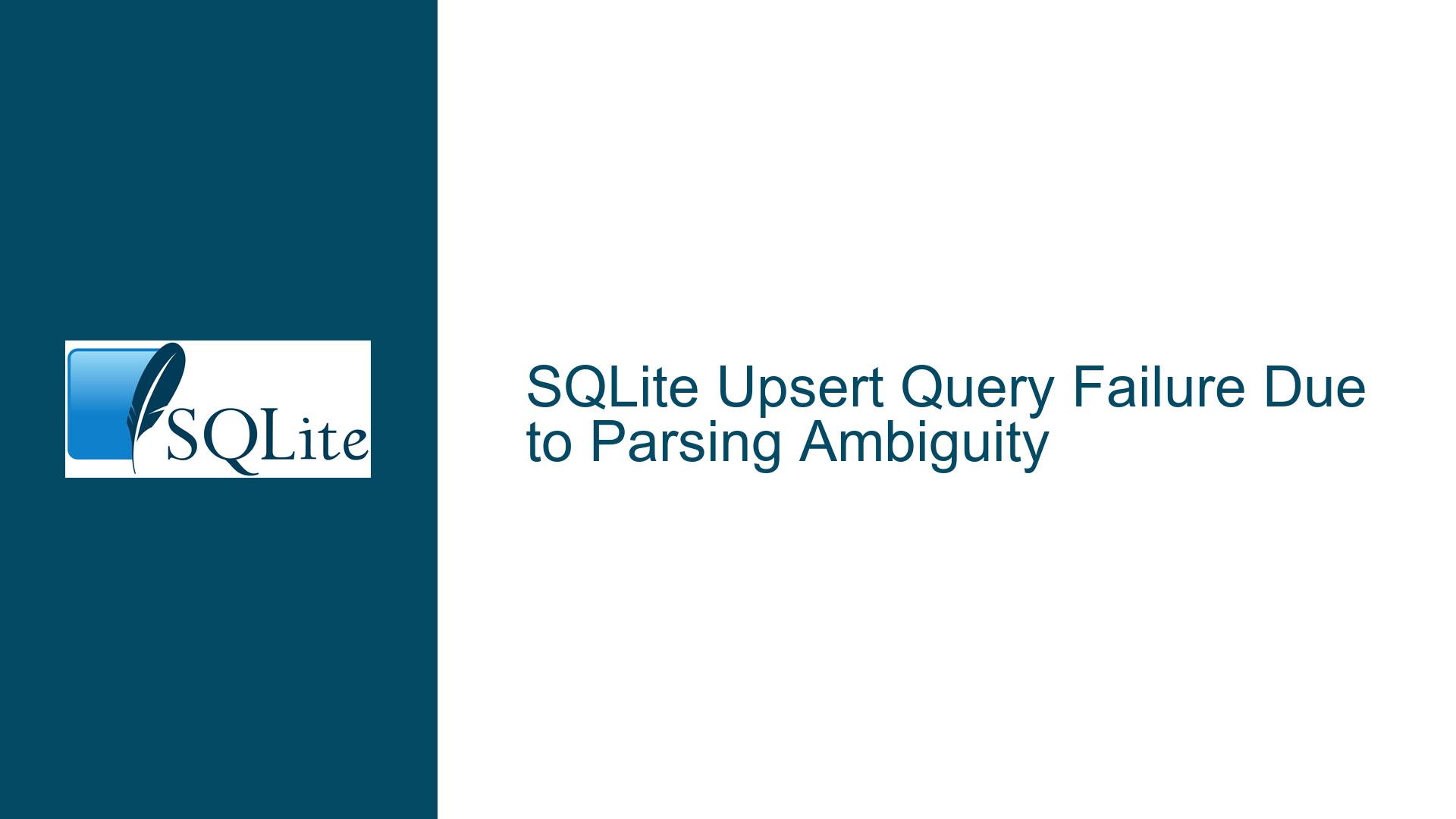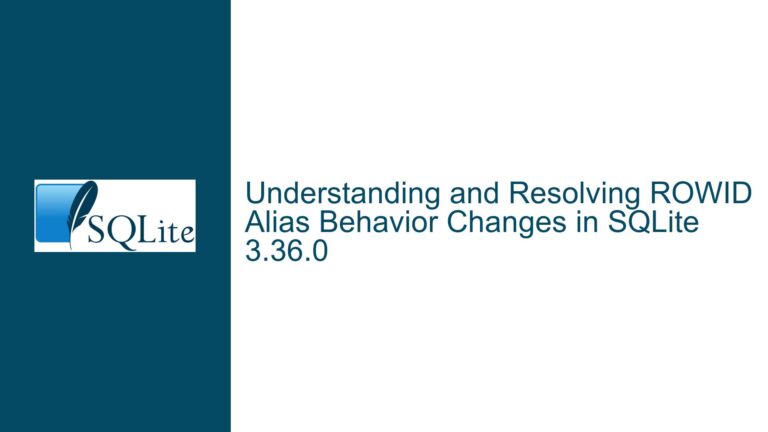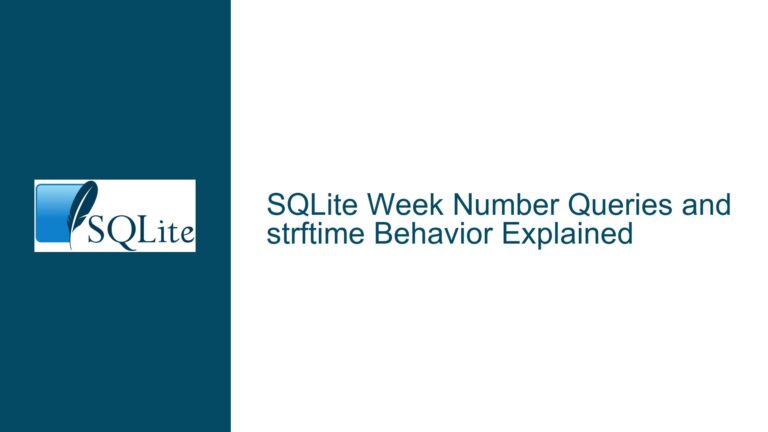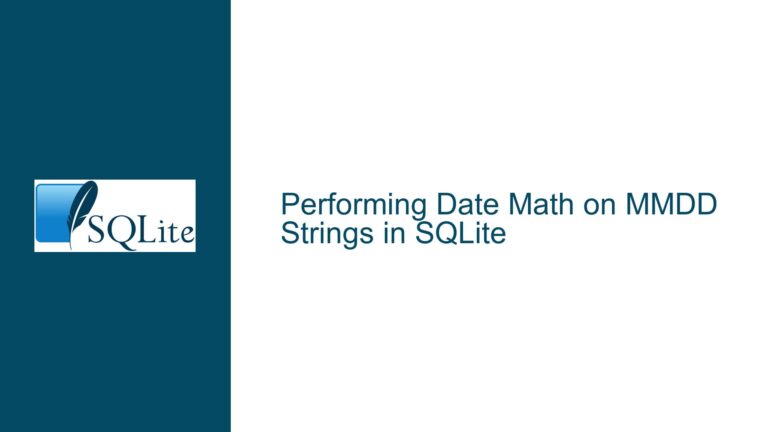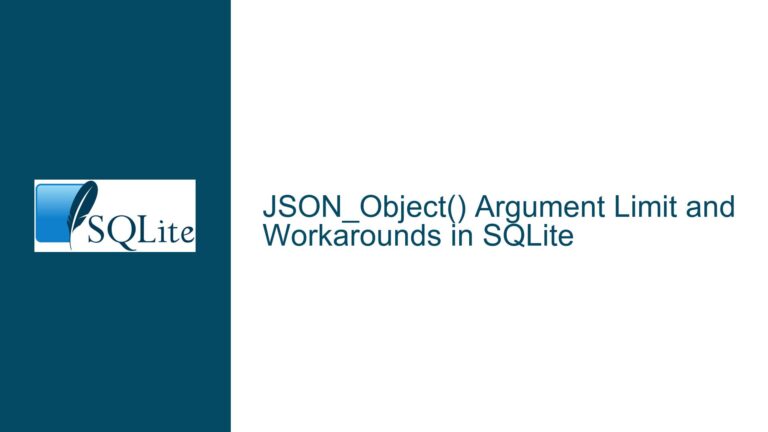SQLite Upsert Query Failure Due to Parsing Ambiguity
SQLite Upsert Query Failure When Transitioning from INSERT OR REPLACE
When transitioning from the INSERT OR REPLACE syntax to the native UPSERT syntax in SQLite, users may encounter a specific failure scenario. This issue arises when attempting to use the ON CONFLICT clause in conjunction with a SELECT statement that sources data from a JSON array. The query, which works perfectly with INSERT OR REPLACE, fails when rewritten to use the UPSERT syntax. The failure is not due to a logical error in the query itself but rather due to a parsing ambiguity in SQLite’s query processing engine.
The table in question, test_people, has a primary key on the job column. The initial query uses INSERT OR REPLACE to insert or update records based on the job column. When the query is modified to use the UPSERT syntax, it fails to execute, leading to confusion and frustration. The solution, as discovered, involves adding a WHERE TRUE clause to resolve the parsing ambiguity.
Parsing Ambiguity in SQLite’s UPSERT Syntax
The root cause of the failure lies in how SQLite’s parser interprets the ON CONFLICT clause when it follows a SELECT statement. SQLite’s parser can sometimes struggle to distinguish between the end of the SELECT statement and the beginning of the ON CONFLICT clause. This parsing ambiguity is particularly pronounced when the SELECT statement is complex, such as when it involves JSON functions like json_extract and json_each.
The INSERT OR REPLACE syntax does not suffer from this issue because it is a simpler, more straightforward operation. The OR REPLACE clause is a directive that tells SQLite to replace the existing row if a conflict occurs. However, the UPSERT syntax, which uses the ON CONFLICT clause, requires the parser to understand the relationship between the SELECT statement and the conflict resolution logic. This is where the ambiguity arises.
The WHERE TRUE clause acts as a delimiter that helps the parser correctly identify the boundary between the SELECT statement and the ON CONFLICT clause. Without this delimiter, the parser may misinterpret the query, leading to a syntax error. This is not a bug in SQLite but rather a limitation of the parser’s ability to handle certain complex query structures.
Resolving Parsing Ambiguity with WHERE TRUE and Best Practices
To resolve the parsing ambiguity and ensure that the UPSERT query works as intended, the WHERE TRUE clause must be added to the query. This clause serves as a no-op condition that forces the parser to correctly interpret the query structure. The corrected query looks like this:
INSERT INTO "test_people" ("job", "age", "name")
SELECT json_extract(value, "$.job") AS "job",
json_extract(value, "$.age") AS "age",
json_extract(value, "$.name") AS "name"
FROM json_each('[{"job":"Presenter","age":31,"name":"Tiffany"},{"job":"Speaker","age":32,"name":"Meredith"}]')
WHERE TRUE
ON CONFLICT ("job")
DO UPDATE SET "age" = EXCLUDED."age", "name" = EXCLUDED."name";
The WHERE TRUE clause ensures that the parser correctly identifies the end of the SELECT statement and the beginning of the ON CONFLICT clause. This resolves the parsing ambiguity and allows the query to execute successfully.
In addition to adding the WHERE TRUE clause, there are several best practices that can help avoid similar issues when working with UPSERT queries in SQLite:
Use Explicit Delimiters: When constructing complex queries, especially those involving JSON functions, always use explicit delimiters like
WHERE TRUEto help the parser understand the query structure.Test Queries Incrementally: When transitioning from
INSERT OR REPLACEtoUPSERT, test the query incrementally. Start with a simpleINSERTstatement, then add theSELECTclause, and finally add theON CONFLICTclause. This helps identify where the parsing ambiguity arises.Understand SQLite’s Parser Limitations: SQLite’s parser is designed to be lightweight and fast, which means it has certain limitations when it comes to handling complex queries. Understanding these limitations can help you write queries that are more likely to succeed.
Consult the Documentation: SQLite’s documentation provides detailed information on the
UPSERTsyntax and the potential for parsing ambiguity. Always refer to the documentation when encountering issues with query syntax.Use Query Builders or ORMs: If you frequently work with complex queries, consider using a query builder or an ORM (Object-Relational Mapping) tool. These tools can help abstract away some of the complexities of SQLite’s query syntax and reduce the likelihood of encountering parsing ambiguities.
By following these best practices and understanding the nuances of SQLite’s query parser, you can avoid issues like the one described and ensure that your UPSERT queries execute successfully.
Detailed Explanation of the Query Components
To further understand why the WHERE TRUE clause is necessary, let’s break down the components of the query and how SQLite’s parser interprets them.
The SELECT Statement
The SELECT statement in the query is responsible for extracting data from a JSON array and converting it into a format that can be inserted into the test_people table. The json_each function is used to iterate over each object in the JSON array, and the json_extract function is used to extract specific values from each object.
SELECT json_extract(value, "$.job") AS "job",
json_extract(value, "$.age") AS "age",
json_extract(value, "$.name") AS "name"
FROM json_each('[{"job":"Presenter","age":31,"name":"Tiffany"},{"job":"Speaker","age":32,"name":"Meredith"}]')
This part of the query is straightforward and works as expected. However, when combined with the ON CONFLICT clause, the parser can become confused about where the SELECT statement ends and the ON CONFLICT clause begins.
The ON CONFLICT Clause
The ON CONFLICT clause is used to specify what should happen if a conflict occurs during the INSERT operation. In this case, the conflict is defined by the primary key on the job column. If a row with the same job value already exists, the ON CONFLICT clause instructs SQLite to update the existing row with the new values.
ON CONFLICT ("job")
DO UPDATE SET "age" = EXCLUDED."age", "name" = EXCLUDED."name"
The EXCLUDED keyword refers to the row that was attempted to be inserted, allowing you to access the values that caused the conflict. This is a powerful feature that allows for complex conflict resolution logic.
The Parsing Ambiguity
The parsing ambiguity arises because SQLite’s parser is not always able to correctly determine where the SELECT statement ends and the ON CONFLICT clause begins. This is particularly true when the SELECT statement is complex, as in this case, where it involves JSON functions.
Without the WHERE TRUE clause, the parser may misinterpret the query, leading to a syntax error. The WHERE TRUE clause acts as a clear delimiter that helps the parser correctly identify the boundary between the SELECT statement and the ON CONFLICT clause.
The Role of WHERE TRUE
The WHERE TRUE clause is a simple condition that always evaluates to true. It does not affect the logic of the query but serves as a delimiter that helps the parser correctly interpret the query structure.
WHERE TRUE
By adding this clause, you are explicitly telling the parser where the SELECT statement ends and where the ON CONFLICT clause begins. This resolves the parsing ambiguity and allows the query to execute successfully.
Conclusion
Transitioning from INSERT OR REPLACE to UPSERT in SQLite can be challenging, especially when dealing with complex queries that involve JSON functions. The parsing ambiguity that arises when combining a SELECT statement with an ON CONFLICT clause can lead to query failures. However, by understanding the root cause of the issue and using explicit delimiters like WHERE TRUE, you can ensure that your UPSERT queries execute successfully.
In addition to resolving the parsing ambiguity, following best practices such as testing queries incrementally, understanding SQLite’s parser limitations, and consulting the documentation can help you avoid similar issues in the future. By taking these steps, you can leverage the full power of SQLite’s UPSERT syntax and ensure that your database operations are both efficient and reliable.
